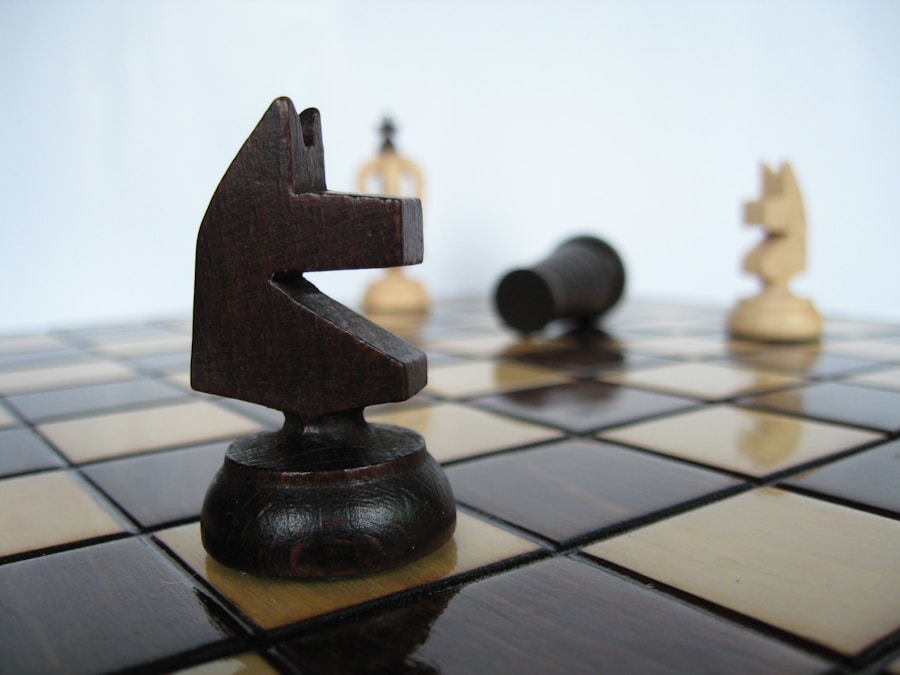Download links
How to install Mastering Chess: Strategies for Success APK?
1. Tap the downloaded Mastering Chess: Strategies for Success APK file.
2. Touch install.
3. Follow the steps on the screen.
Description
Chess is a strategic board game that has captivated minds for centuries, originating in India around the 6th century AD before spreading to Persia and then to Europe. The game is played on an 8×8 grid, known as a chessboard, where two players command an army of 16 pieces each: one side plays with white pieces, while the other uses black. Each player’s army consists of one king, one queen, two rooks, two knights, two bishops, and eight pawns.
The objective is to checkmate the opponent’s king, which means putting it in a position where it cannot escape capture. Understanding the movement and capabilities of each piece is fundamental to mastering chess. The king moves one square in any direction, while the queen can traverse any number of squares along a rank, file, or diagonal.
Rooks move in straight lines along ranks and files, bishops glide diagonally across the board, and knights have a unique L-shaped movement that allows them to jump over other pieces. Pawns move forward one square but capture diagonally, and they have the special ability to advance two squares on their first move. This intricate dance of pieces creates a rich tapestry of tactical possibilities and strategic depth that players must navigate.
Key Takeaways
- Chess involves two players, each with 16 pieces, and the objective is to checkmate the opponent’s king.
- A strong opening repertoire involves understanding and mastering various opening moves and their potential outcomes.
- Tactical play involves creating threats and opportunities, while positional play focuses on long-term strategic advantages.
- Improving endgame techniques requires understanding the principles of pawn promotion, piece activity, and king activity.
- Mental toughness and focus are essential for maintaining concentration and making sound decisions throughout the game.
- Studying and analyzing grandmaster games can provide valuable insights into advanced strategies and tactics.
Developing a Strong Opening Repertoire
A well-structured opening repertoire is essential for any serious chess player. The opening phase of the game sets the stage for the middle game and can significantly influence the outcome. Players must familiarize themselves with various opening principles, such as controlling the center of the board, developing pieces efficiently, and ensuring king safety through castling.
A strong opening repertoire not only provides players with a solid foundation but also helps them avoid falling into traps set by their opponents. One popular opening is the Ruy Lopez, named after a 16th-century Spanish priest. It begins with 1.e4 e5 2.Nf3 Nc6 3.Bb5, where White aims to control the center while putting pressure on the knight that defends the e5 pawn.
Another well-known opening is the Sicilian Defense, which arises after 1.e4 c5. This opening allows Black to counterattack and create imbalances in the position, often leading to dynamic and complex middlegame scenarios. By studying these openings and their variations, players can develop a repertoire that suits their style and prepares them for various responses from their opponents.
Mastering Tactical and Positional Play

Tactical awareness is crucial in chess, as it allows players to recognize opportunities for immediate gain or threats that need addressing. Tactics often involve combinations that lead to material advantage or checkmate. Common tactical motifs include forks, pins, skewers, discovered attacks, and double attacks.
For instance, a fork occurs when a single piece attacks two or more enemy pieces simultaneously, forcing the opponent to choose which piece to save. Mastering these tactics requires practice and familiarity with common patterns. Positional play, on the other hand, focuses on long-term advantages rather than immediate gains.
It involves evaluating the strengths and weaknesses of both sides’ positions and making strategic decisions based on that assessment. Factors such as pawn structure, piece activity, control of key squares, and king safety are all critical in positional play. For example, a player may choose to exchange pieces to simplify a position when they have a material advantage or to maintain tension when they have better piece activity.
Balancing tactical opportunities with positional considerations is essential for achieving success in chess.
Improving Endgame Techniques
| Technique | Success Rate | Time Saved |
|---|---|---|
| King and Pawn vs King | 85% | 10 minutes |
| Rook Endgames | 70% | 15 minutes |
| Bishop and Knight Checkmate | 60% | 20 minutes |
The endgame is often where many games are decided, yet it is frequently overlooked by players who focus primarily on openings and middlegame tactics. Understanding endgame principles can turn a drawn position into a win or salvage a lost game into a draw. Key concepts include knowing how to convert material advantages into victory and recognizing when to simplify the position by exchanging pieces.
For instance, if a player has an extra pawn in an endgame scenario, they should aim to promote that pawn while keeping their king active. One classic endgame scenario is the king and pawn versus king endgame. The player with the pawn must use their king to support its advance while preventing the opposing king from blocking its path.
Understanding concepts like opposition—where one king directly faces another king with an odd number of squares between them—can be pivotal in achieving victory. Additionally, players should familiarize themselves with key theoretical positions such as the Lucena and Philidor positions in rook endgames, which provide essential techniques for converting advantages into wins.
Enhancing Mental Toughness and Focus
Chess is as much a mental battle as it is a physical one; thus, mental toughness plays a crucial role in a player’s performance. The ability to maintain focus during long games can be challenging, especially when fatigue sets in or when faced with unexpected moves from an opponent. Developing mental resilience involves practicing mindfulness techniques that help players stay present and engaged throughout the game.
Techniques such as visualization can also enhance concentration by allowing players to mentally rehearse potential moves and outcomes before making decisions. Moreover, managing emotions during play is vital for maintaining composure under pressure. Players often experience anxiety or frustration when faced with difficult positions or time constraints.
Learning to accept mistakes as part of the game rather than as personal failures can help mitigate negative emotions. Engaging in regular self-reflection after games can also foster growth; analyzing what went well and what could be improved allows players to build confidence and develop strategies for future encounters.
Studying and Analyzing Grandmaster Games

One of the most effective ways to improve at chess is by studying games played by grandmasters. These elite players often demonstrate advanced strategies and techniques that can provide valuable insights into high-level play. Analyzing grandmaster games allows players to observe how top competitors handle various openings, middlegame tactics, and endgame scenarios.
Resources such as databases of historical games or online platforms featuring annotated games can serve as excellent tools for this purpose. When studying grandmaster games, it is beneficial to focus on specific themes or positions that resonate with one’s own style of play. For example, if a player enjoys aggressive tactics, they might analyze games by renowned tacticians like Mikhail Tal or Garry Kasparov.
Conversely, those who prefer positional play might study games by Anatoly Karpov or José Raúl Capablanca.
In conclusion, chess is a multifaceted game that requires a blend of knowledge, skill, and psychological fortitude.
By mastering the basics, developing a strong opening repertoire, honing tactical and positional skills, improving endgame techniques, enhancing mental toughness, and studying grandmaster games, players can elevate their understanding of chess and improve their performance on the board. Each aspect contributes to a holistic approach to learning this timeless game, ensuring that players are well-equipped to face opponents at any level.
If you’re looking for a way to stay connected with friends and family while playing chess, you might want to check out WhatsApp Messenger. This messaging app allows you to chat, make video calls, and share photos and videos with your loved ones. It’s a great way to keep in touch with your chess buddies and discuss strategies for your next game. For more information on how to use WhatsApp Messenger, you can read the article here.
FAQs
What is chess?
Chess is a two-player strategy board game that is played on an 8×8 grid. It is one of the most popular and enduring games in the world, with a rich history dating back over 1500 years.
How is chess played?
Chess is played on a square board divided into 64 squares of alternating colors. Each player starts with 16 pieces: one king, one queen, two rooks, two knights, two bishops, and eight pawns. The objective of the game is to checkmate the opponent’s king, which means putting the king into a position where it cannot escape capture.
What are the basic rules of chess?
Each type of chess piece moves in a specific way. The king moves one square in any direction, the queen moves any number of squares in any direction, the rook moves any number of squares horizontally or vertically, the bishop moves any number of squares diagonally, the knight moves in an L-shape, and the pawn moves forward one square and captures diagonally. The game ends when a player’s king is in checkmate, or when a stalemate is reached.
What are the benefits of playing chess?
Chess has been shown to have numerous cognitive benefits, including improving memory, concentration, problem-solving skills, and strategic thinking. It is also a great way to improve patience and decision-making abilities.
What is the history of chess?
Chess originated in India around the 6th century and spread to Persia, where it became known as “shatranj.” It then spread to the Arab world and Europe, evolving into the modern game of chess that we know today. Chess has a rich and storied history, with many famous players and memorable games.





